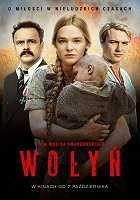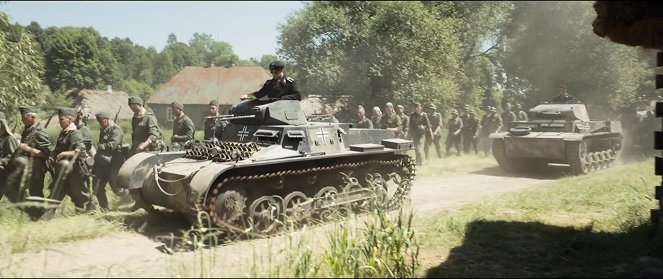Directed by:
Wojciech SmarzowskiScreenplay:
Wojciech SmarzowskiCinematography:
Piotr Sobociński Jr.Composer:
Mikolaj TrzaskaCast:
Michalina Łabacz, Arkadiusz Jakubik, Wasyl Wasylik, Adrian Zaremba, Jacek Braciak, Tomasz Sapryk, Izabela Kuna, Kinga Preis, Jaroslaw Gruda (more)Plots(1)
Volhynia is both a name referring to a historic border region between Poland, Ukraine and Belarus, and a byword for a series of brutal massacres occurring between 1943-1945. Polish auteur Wojtek Smarzowski turns his misanthropic eye to this disorienting period of history, exploring the region's chaotic descent into hell through the will to survive of a young Ukrainian farm girl. It makes for a chilling and graphically violent account of the ugly growth of nationalism. (Edinburgh International Film Festival)
(more)Reviews (5)
The Poles takes advantage of their strong filmography period and open one brutal historical topic after another every single year. In the case of the movie Volhynia they go back to the Second World War and clearly show how the locals lived peacefully until the war began. At that moment something weird happened with local people and it turned them into even bigger monsters than the Germans who are in this movie actually portrayed as the good guys… unlike the Ukrainians and the Poles. Because of the horror of some scenes I wouldn’t have a problem to compare this movie to Russian Come and See. If you see something terrible, then can expect to see something even worse in the next minute. After a while you will become so numb that you will only stare dumbly at the screen, uncomprehending how far the Ukrainian struggle for independence could have gone. Absolute horror… I had no words. I have to admit I had no idea something like this even happened in East Poland. Personally, I would be very interested to know how the Poles feel about their neighbors now. When somebody talk to me about how much we, the Czech people, collaborated with the Germans during the WWII, I will probably tell them about the monsters living in Volhynia at that time… An incredible movie, which everybody who is interested in war should watch to see what war can actually do to people…
()
(Non) humanized (non) adaptation of Snyder's freezing Bloody Lands in the form of Ukrainian-Polish-German-Russian-Jewish (non) coexistence. But it is sadly fragmented into individual scenes from hell à la Come and see at the expense of cohesion. Gradually, the viewer becomes apathetic in the same way the main character does. Whether or not it was a purpose and how much it is / is not useful to the overall experience is a completely different question.
()
What Klimov's film Come and See meant for the residents of the former Soviet Union - a reminder of the Belarusian genocide - the film Hatred means for today's Polish society. It is a memory of the so-called Volhynian massacre when at least 60,000 Poles were massacred in several stages. We will never find out the exact number, because many villages and towns were razed and burned to the ground. Units of the Ukrainian Insurgent Army, known as the "Banderites," in brotherly cooperation with Ukrainian civilians, who willingly participated with their axes, scythes, sickles, and knives, thoroughly cleansed the Volhynian territory of unwanted elements. The brutality with which they carried out their vision of Ukraine rid of all weeds shocked not only ordinary soldiers in the Wehrmacht, but even hardened members of the SS units. Too many Ukrainians regarded the pogrom as a joyful happening, following the principle that it is an unforgivable transgression to kill, when you can first torture with impunity. And so, happily, they peeled off the skin, gouged out eyes, and impaled children through their rectums, without exception. According to historians, Europe has not experienced a similar kind of violence since the Mongol-Tatar invasions. Hatred is a dark film based on a harsh reality. Modern technology enables us to see ancient atrocities far more realistically and explicitly than older war films and director Smarzowski is not ashamed to use it. We had to interrupt the viewing several times and clear our heads, and it definitely wasn't due to the film's 150-minute length. This is an inevitable consequence of the film's effort to show the massacres in a deeper context, to reveal the process by which friends and peaceful neighbors turn into executioners. Timothy Snyder's book "Black Earth" is an excellent aid in understanding the film's realities. Hatred is an extraordinary film not only because of its serious subject matter but also because of the quality of its execution. The set design, cinematography, and performances are all exceptional. It is particularly worth highlighting Michalina Labacz's performance in the lead role. It is a thunderous debut. From a carefree romantic girl experiencing her first infatuation to a prematurely mature woman who, as the head of the family, takes care of the entire estate, she undergoes a compelling character arc, transforming into a half-mad human wreck, who tries with all her willpower to rescue her child from hell. It is as absurd to blame today's residents of Ukraine for the past atrocities of the "Banderites" as it is to blame today's residents of Western Europe for the sins of the colonial period. At the same time, it is necessary to categorically reject the purposeful argumentation of Putin justifying his interference in the situation in Ukraine. But it is also equally necessary to reflect on the ban on showing the film in Ukrainian movie theaters and to remind ourselves that Ukrainian historians and media are trying to trivialize and rewrite history regarding the Volhynian massacre. Overall impression: 95%. I will remember for a long time how Smarzowski builds tension, for example in the scene where a Polish military returnee encounters a car with Ukrainian loggers, who conspicuously hold their axes, and he tries to pass himself off as one of them, ending up at a nationalistic celebration of triumphant Ukrainians...
()
(less)
(more)
Wannabe Come and See that gives the audience a thorough lesson in gratuitousness. Whereas the Soviet masterpiece worked brilliantly with subjective perspective and presented the atrocities of war as if naturally – often only through fleeting point-of-view shots or through sound and off-screen action – here every death must be like something out of torture porn. While the main character guides the events, the story crumbles into multiple episodes, each ending with just another brutal killing, and inadvertently creating a chaos that is difficult to navigate. In doing so, the film applies a sub-genre about a community of characters who treat each other differently at different times, but lacks psychological clues for the abrupt transition between stages, relying only on chaos, marked by brutality and the idea that everyone is a bastard. Sure, almost all of them are scum in a corner of their souls, and the moral lines are blurred during the war in ways I don't even want to imagine (and the film certainly doesn't lie about that), but as a history lesson, Volhynia is just terribly self-serving and repetitive. If you haven't seen it and miss the possibility of comparison, you should take a quick look at Come and See.
()
At first, I was under the impression that I was watching an educational documentary about Volhynian folklore, but then it turned out that the creators made a film that steamrolled even my cynicism-soaked soul. I don’t feel like joking this time, the film aroused only disgust and feelings of unease. What I liked about it was that it didn’t take sides. Both sides were equally bad, which corresponded to reality. The atmosphere was perfect (raw and chilling), the tension was ever-present and the strain on the psyche was tremendous. As I have already said, no one was spared, but if the Ukrainians consider Bandera nationalists to be heroes, then let Putin keep Crimea...
()

